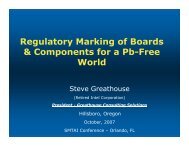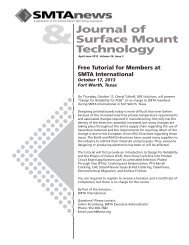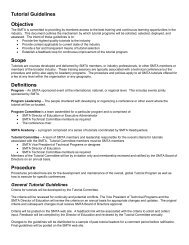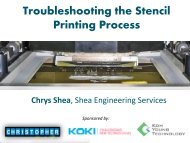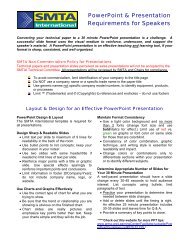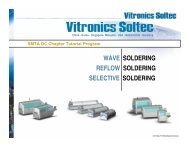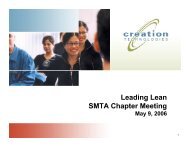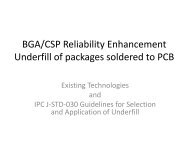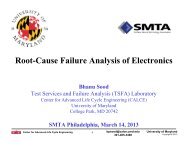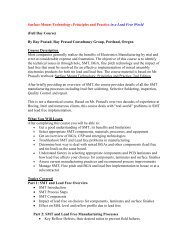Non-Conductive Epoxy Filled Vias in PCB's Provides New ... - SMTA
Non-Conductive Epoxy Filled Vias in PCB's Provides New ... - SMTA
Non-Conductive Epoxy Filled Vias in PCB's Provides New ... - SMTA
You also want an ePaper? Increase the reach of your titles
YUMPU automatically turns print PDFs into web optimized ePapers that Google loves.
<strong>Non</strong>-<strong>Conductive</strong> <strong>Epoxy</strong> <strong>Filled</strong><strong>Vias</strong> <strong>in</strong> PCB’s <strong>Provides</strong> <strong>New</strong>Product Offer<strong>in</strong>gsPresented by:- David Hoover – MultekSr. Field Applications Eng<strong>in</strong>eer06-10-04
Why Hole Fill<strong>in</strong>g?
Via <strong>in</strong> Pad Benefits1. <strong>Provides</strong> a flat coplanar surface. (For component attachment)2. More traces on PCB escap<strong>in</strong>g devices through rout channels.(Results <strong>in</strong> less lyrs / potential lower costs)3. Increased component density. (Due to absence of periphery vias)4. Potential EMI / SI benefits. (Lower Inductance due to no dogbonepads with traces.)5. Thermal dissipation. (Either at lead connections or underdevices – heat pipes)6. No via (Soldermask) plugg<strong>in</strong>g required at the component locations.(<strong>Filled</strong> <strong>Vias</strong> seal off the possibility of solutions wick<strong>in</strong>g up from the bottomside. This also provides a flatter soldermask / pad surface which will yieldgreater feature resolution dur<strong>in</strong>g stencil paste pr<strong>in</strong>t<strong>in</strong>g for assembly)
<strong>Non</strong>-<strong>Conductive</strong> <strong>Filled</strong> <strong>Vias</strong>(Grid Array Package Benefits)Added Rout Channelson Outerlayer(underneath device)Extra Cost Considerations• Hole fill<strong>in</strong>g - (materials)• Planarization – (Mechanical Equipment & Process Time)• Copper Capp<strong>in</strong>g (Additional Drill<strong>in</strong>g and Copper Plat<strong>in</strong>g)
Hole Plugg<strong>in</strong>g – Overview of the ProcessVIP Process flowNC drill<strong>in</strong>gPasteThrough hole plat<strong>in</strong>gPHP selective hole plugg<strong>in</strong>gBack-up boardSolder maskPolish<strong>in</strong>gTo Solder Mask processCopper plat<strong>in</strong>g on surfaceCopper plat<strong>in</strong>g on surfaceImag<strong>in</strong>g
Planarization Equipment - Prototype
Hole Plugg<strong>in</strong>g - ApplicationsHole plugg<strong>in</strong>g for<strong>in</strong>ner processStandard Hole Plug- Increased buried via reliability- Customer requirementHole plugg<strong>in</strong>g forouter processVia <strong>in</strong> Pad- Allow uvia stack over the BVH- Allow via <strong>in</strong> SMT, size reductionLimitations- Aspect Ratio- Filler Particle Size- Production Quantities
Cross Section PhotosAfter Planarization
Cross Section Photos<strong>Filled</strong> Bl<strong>in</strong>d <strong>Vias</strong> 1-2
Cross Section Photos<strong>Filled</strong> Bl<strong>in</strong>d <strong>Vias</strong> 1-3
<strong>Non</strong>-<strong>Conductive</strong> <strong>Filled</strong> <strong>Vias</strong> – ObjectivesThe process developed was able to: Fill the holes to have a better topography Fill the holes to have a “stacked via” design Prove out structures with Reliability Test<strong>in</strong>gA <strong>New</strong> Challenge was Identified Fill holes with an aspect ratio up to 15:1 andm<strong>in</strong>imum diameter of 0.25mm (10 mil)(Current Process is for low volume – R and D)
Depression
Hole Plugg<strong>in</strong>g (epoxy fill<strong>in</strong>g through hole)- DimpleUneven surface <strong>in</strong> the capped via23um25umDimple = 25um (
Depression 350x
3D Mapp<strong>in</strong>g of the Pad Geometry's1.701.200.700.20-0.30-0.80(Mils)1.20-1.700.70-1.200.20-0.70-0.30-0.20-0.80--0.30-1.30--0.80-1.80--1.30-1.30BJ-1.80AU4943373125191372ANAE
Top View of Larger Size Pads and HolesCould be used for Larger Feature Components• Socketed BGAs and LGAs• Surface Mounted High Speed Connectors• Can help fill Via Holes where Solder Volume Wick<strong>in</strong>g is an issue.
Cross Section Photos<strong>Filled</strong> <strong>Vias</strong> <strong>in</strong> larger PTHs
Bubble Example
Cross Section PhotosReliability TestsAfter Soldershock(6 X @ 288’C)
IST Results – (Reliability Tests)PTH performance all 6 headsPTH performance all 6 headschange <strong>in</strong> mohms12011511010510095908580757065605550454035302520151050-5-10-151 13 25 37 49 61 73 85 97 109 121 133 145 157 169 181 193 205 217 229 241 253 265 277 289 301 313 325# of Cycles741-1-1741-1-2741-1-3741-1-4741-1-5741-1-6change <strong>in</strong> mohms12011511010510095908580757065605550454035302520151050-5-10-151 10 19 28 37 46 55 64 73 82 91 100 109 118 127 136 145 154 163 172 181 190 199 208 217 226 235 244 253# of Cycles741-1-1741-1-2741-1-3741-1-4741-1-5741-1-6IST Coupons Without <strong>Filled</strong> <strong>Vias</strong>IST Coupons With <strong>Filled</strong> <strong>Vias</strong>This IST test<strong>in</strong>g suggests that that the Fill<strong>in</strong>g of the <strong>Vias</strong> with <strong>Non</strong>-<strong>Conductive</strong> <strong>Epoxy</strong>produces results that meet (or exceed) the results of standard PTH technology.
SummaryProcess acceptable up to 15:1 AR(Prototype Small R & D Volume Quantities)Scalability possibilitiesProcess suitable for LGA, Socketed BGA, orSurface Mounted Connector Technologies<strong>Non</strong>-<strong>Conductive</strong> <strong>Filled</strong> Via Technology meetscurrent Industry Reliability RequirementsImportant Th<strong>in</strong>gs to Note (Differences <strong>in</strong> Appearance)Small bubbles sometimes presentSmall depressions sometimes present
Future Activities(My Wishlist)• Increased Demand for VIP Technology due to High Speed Requirements(Low Lead <strong>in</strong>ductance)• Increased Demand for VIP Technology due to <strong>in</strong>creased Routability(F<strong>in</strong>er Pitch Components drives the Density Up requir<strong>in</strong>g more Metal Fanout Design Channels)• Thermal Dissipation Possibilities(Copper Plat<strong>in</strong>g Thickness, Connection to Planes, MLF Devices)• NC Dispens<strong>in</strong>g(Precise Application of the Inks / Media)• Full PTH Seal<strong>in</strong>g for Assembly Reliability(Seal<strong>in</strong>g of the Via <strong>in</strong> Pads stops the solder Volume from wick<strong>in</strong>g away from the Solder Jo<strong>in</strong>ts)



